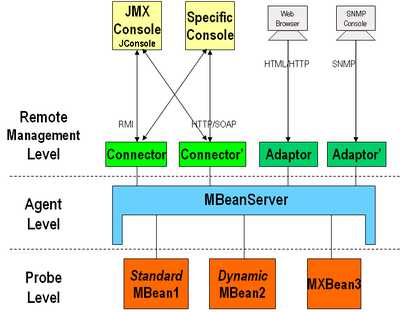标签:
Java Management Extensions (JMX) is a Java technology that supplies tools for managing and monitoring applications, system objects, devices (e.g. printers) and service-oriented networks. Those resources are represented by objects called MBeans (for Managed Bean).
JMX uses a three-level architecture:

A managed bean - sometimes simply referred to as an MBean - is a type of JavaBean, created with dependency injection. Managed Beans are particularly used in the Java Management Extensions technology. But with Java EE 6, the specification provides for a more detailed meaning of a managed bean.
The MBean represents a resource running in the Java virtual machine, such as an application or a Java EE technical service (transactional monitor, JDBC driver, etc.). They can be used for collecting statistics on concerns like performance, resources usage, or problems (pull); for getting and setting application configurations or properties (push/pull); and notifying events like faults or state changes (push).
There are two basic types of MBean:
javax.management.DynamicMBean interface that provides a way to list the attributes and operations, and to get and set the attribute values.Additional types are Open MBeans, Model MBeans and Monitor MBeans. Open MBeans are dynamic MBeans that rely on the basic data types. They are self-explanatory and more user-friendly. Model MBeans are dynamic MBeans that can be configured during runtime. A generic MBean class is also provided for dynamically configuring the resources during program runtime.
An MXBean (Platform MBean) is a special type of MBean that reifies Java Virtual Machine subsystems such as garbage collection, JIT compilation, memory pools, multi-threading, etc.
标签:
原文地址:http://www.cnblogs.com/zno2/p/4571766.html